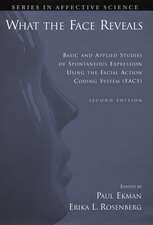Neuroinformatics for Neuropsychology
Autor Vinoth Jagarooen Limba Engleză Paperback – 29 noi 2014
The Human Genome Project, which depended on informatics methods, has been the most well recognized bioinformatics undertaking. Bioinformatics has since been applied all across biology and medicine, and has also transformed almost every avenue in neuroscience. Yet in neuropsychology, NI perspectives remain largely unrealized. Ironically, NI offers enormous potential to the essential praxis of neuropsychology - assessing cognitive behavior and relating cognition to neural systems. Neuroinformatics can be applied to neuropsychology as richly as it has been applied across the neurosciences.
Neuroinformatics for Neuropsychology is the first book to explain the relevance and value of NI to neuropsychology. It systematically describes NI tools, applications and models that can enhance the efforts of neuropsychologists. It also describes the implications of NI for neuropsychology in the 21st century – fundamental shifts away from the conventional modes of research, practice and communication that have thus far characterized the field. One of the foremost experts on the subject:
- Illustrates the vital role NI is playing throughout the neurosciences.
- Provides a sampling of NI tools and applications in neuroscience research, and lays out current organization structures that support NI.
- Describes the lack of NI in neuropsychology, differentiates between NI systems for neuropsychology and conventional computerized assessment methods, and proposes criteria for neuropsychology-specific NI systems.
- DescribesNI applications and models currently in use in neuropsychology, and NI models for neuropsychology that are being pioneered in phenomics research.
- Discusses potential obstacles and aids to NI in neuropsychology, including issues such as data sharing, standardization of methods, and data ontology.
- Projects the future of neuropsychological research and practice in light of the new generation of the internet, Web 2.0, geared to collective knowledge building.
| Toate formatele și edițiile | Preț | Express |
|---|---|---|
| Paperback (1) | 632.70 lei 43-57 zile | |
| Springer – 29 noi 2014 | 632.70 lei 43-57 zile | |
| Hardback (1) | 638.89 lei 43-57 zile | |
| Springer – 21 aug 2009 | 638.89 lei 43-57 zile |
Preț: 632.70 lei
Preț vechi: 744.35 lei
-15% Nou
Puncte Express: 949
Preț estimativ în valută:
121.06€ • 126.74$ • 100.17£
121.06€ • 126.74$ • 100.17£
Carte tipărită la comandă
Livrare economică 07-21 aprilie
Preluare comenzi: 021 569.72.76
Specificații
ISBN-13: 9781489983084
ISBN-10: 1489983082
Pagini: 140
Ilustrații: XIV, 124 p.
Dimensiuni: 155 x 235 x 7 mm
Greutate: 0.2 kg
Ediția:2009
Editura: Springer
Colecția Springer
Locul publicării:New York, NY, United States
ISBN-10: 1489983082
Pagini: 140
Ilustrații: XIV, 124 p.
Dimensiuni: 155 x 235 x 7 mm
Greutate: 0.2 kg
Ediția:2009
Editura: Springer
Colecția Springer
Locul publicării:New York, NY, United States
Public țintă
Professional/practitionerCuprins
1. Introduction.- 1.1 Overview of Bioinformatics.- 1.2 What Is Neuroinformatics?- 1.3 Bringing Neuroinformatics to Neuropsychology.- 2. Current Neuroinformatics Applications and Infrastructure.- 2.1 Brain Image Databases.- 2.2 Brain Image Reconstruction and Morphometric Tools.- 2.3 Databases and Tools for Neural Structure and Connectivity Patterns.- 2.4 Tools for Simulation of Neuronal Function and Neural Circuits.- 2.5 Neuroinformatics Database Systems for Clinical and Academic Research.- 2.6 Neuroinformatics Management and Infrastructure.- 3. Neuroinformatics and Neuropsychology.- 3.1 Differentiating Between General Computer Applications in Neuropsychology and Neuroinformatics Systems for Neuropsychology.- 3.2 Defining Neuropsychology-Specific Neuroinformatic Systems.- 3.3. Examples of Neuroinformatics Applications Designed for Neuropsychology.- 3.4 Obstacles and Aids to NI in Neuropsychology.- 3.5. An International Working Group for Neuroinformatics in Neuropsychology.- 4. Concluding Remarks.
Recenzii
From the reviews:“Neuropsychology meets the field of neuroinformatics (NI) in this short text … by Vinoth Jagaroo. … the premise of this book is critically important and timely for the field of neuropsychology, both experimental and clinical. … Neuroinformatics for Neuropsychology, the first book of its kind to deal with this topic with specific implications for clinical neuropsychology … .” (Erin D. Bigler, PsycCRITIQUES, Vol. 55 (17), April, 2010)
Notă biografică
Vinoth Jagaroo is a cognitive neuroscientist. His primary interests are neuroinformatics applied to neuropsychology, and spatial cognition. He is an Associate Professor in the Department of Communication Sciences and Disorders at Emerson College (Boston) and in the Department of Psychiatry and the Behavioral Neuroscience Program at Boston University School of Medicine. His recent book, Neuroinformatics for Neuropsychology (Springer, 2009) is the first to explain the relevance of neuroinformatics to neuropsychology. He is also the founding member of the recently launched Society for Neuroinformatics in Neuropsychology.
Textul de pe ultima copertă
Neuroinformatics for Neuropsychology
Vinoth Jagaroo
Emerson College and Boston University School of Medicine, Boston, MA, USA
Bioinformatics involves specialized application of computer technology to investigative and conceptual problems in biology and medicine; neuroinformatics (NI) is the practice of bioinformatics in the neurosciences. Over the past two decades the biomedical sciences have been revolutionized by databases, data mining and data modeling techniques.
The Human Genome Project, which depended on informatics methods, has been the most well recognized bioinformatics undertaking. Bioinformatics has since been applied all across biology and medicine, and has also transformed almost every avenue in neuroscience. Yet in neuropsychology, NI perspectives remain largely unrealized. Ironically, NI offers enormous potential to the essential praxis of neuropsychology - assessing cognitive behavior and relating cognition to neural systems. Neuroinformatics can be applied to neuropsychology as richly as it has been applied across the neurosciences.
Neuroinformatics for Neuropsychology is the first book to explain the relevance and value of NI to neuropsychology. It systematically describes NI tools, applications and models that can enhance the efforts of neuropsychologists. It also describes the implications of NI for neuropsychology in the 21st century – fundamental shifts away from the conventional modes of research, practice and communication that have thus far characterized the field. One of the foremost experts on the subject:
Vinoth Jagaroo
Emerson College and Boston University School of Medicine, Boston, MA, USA
Bioinformatics involves specialized application of computer technology to investigative and conceptual problems in biology and medicine; neuroinformatics (NI) is the practice of bioinformatics in the neurosciences. Over the past two decades the biomedical sciences have been revolutionized by databases, data mining and data modeling techniques.
The Human Genome Project, which depended on informatics methods, has been the most well recognized bioinformatics undertaking. Bioinformatics has since been applied all across biology and medicine, and has also transformed almost every avenue in neuroscience. Yet in neuropsychology, NI perspectives remain largely unrealized. Ironically, NI offers enormous potential to the essential praxis of neuropsychology - assessing cognitive behavior and relating cognition to neural systems. Neuroinformatics can be applied to neuropsychology as richly as it has been applied across the neurosciences.
Neuroinformatics for Neuropsychology is the first book to explain the relevance and value of NI to neuropsychology. It systematically describes NI tools, applications and models that can enhance the efforts of neuropsychologists. It also describes the implications of NI for neuropsychology in the 21st century – fundamental shifts away from the conventional modes of research, practice and communication that have thus far characterized the field. One of the foremost experts on the subject:
- Illustrates the vital role NI is playing throughout the neurosciences.
- Provides a sampling of NI tools and applications in neuroscience research, and lays out current organization structures that support NI.
- Describes the lack of NI in neuropsychology, differentiates between NI systems forneuropsychology and conventional computerized assessment methods, and proposes criteria for neuropsychology-specific NI systems.
- Describes NI applications and models currently in use in neuropsychology, and NI models for neuropsychology that are being pioneered in phenomics research.
- Discusses potential obstacles and aids to NI in neuropsychology, including issues such as data sharing, standardization of methods, and data ontology.
- Projects the future of neuropsychological research and practice in light of the new generation of the internet, Web 2.0, geared to collective knowledge building.
Caracteristici
The only book available to bring together neuroinformatics and neuropsychology, creating its own sub-discipline in neuropsychology Includes seven examples of neuroinformatics applications designed for clinical neuropsychology











